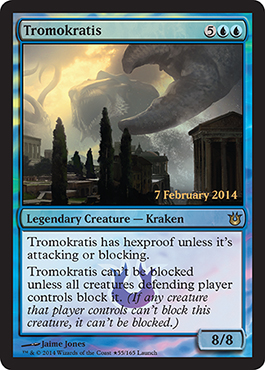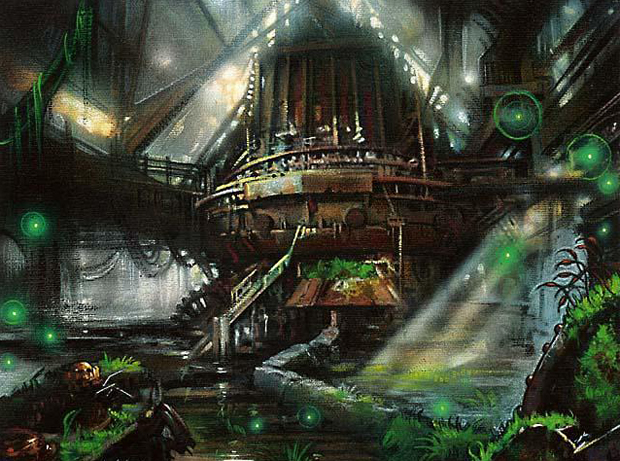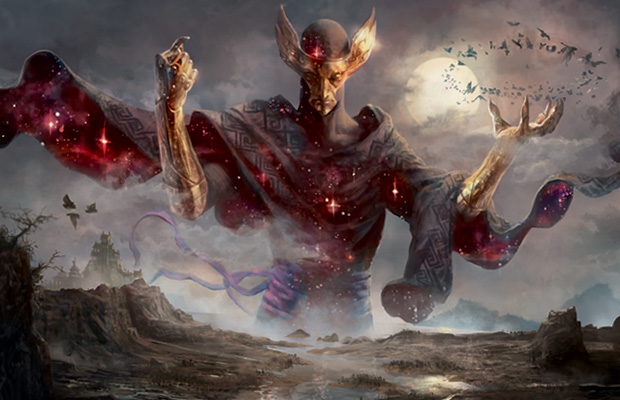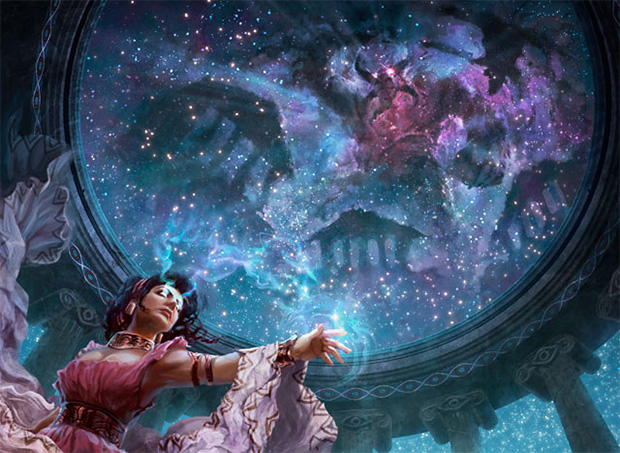By: Travis Allen
In a few days we get to play with Born of the Gods, perhaps one of the worst winter sets in quite some time. There’s very little in this set to be excited about. Brimaz is awesome, and some of the gods may be decent, but overall there just is not a lot here. It’s being called the second Dragon’s Maze, which is Voice of Resurgence, Blood Baron of Vizkopa, and 154 cards on which to proxy. Overall, there’s not much here to work with, either financially or playably. Grab a set of Brimaz, maybe some Xenagos, and call it a day.
We’re still going to check it out though, so let’s see what BNG has in store for us. Any rare I don’t mention I perceive as total bulk, and has no need to be discussed here.
D(jk2m2389/i4NkDCksvL_EN.jpg)
Brimaz, King of Oreskos
We’re starting with the hottest mythic of the set. Admittedly, the first time I parsed the card I was unmoved. I’m not a white weenie player, and this guy seemed exactly fine. LSV’s review caused me to upgrade my expectations. There’s a good chance the lion king will be pooping tokens out for his entire tenure in Standard, and could pretty conceivably cut it in Modern too. He does a fantastic Hero of Bladehold impression for one less mana, and while he doesn’t battle cry your team, he starts attacking earlier and plays solid defense in races. In addition, Bile Blight doesn’t kill him, which is going to matter a whole lot real soon.
Preorders for Brimaz are around $25 at the moment. This is still in the prerelease honeymoon period, but out of all the mythics, Brimaz is the clear front runner. I would guess that he won’t manage to get much lower than $10 ever, if even that low. If he sinks as low as $15 I wouldn’t hesitate to start grabbing copies, and under $15 go hog wild. If you are dying to play with him right now I think you could do worse than buying a set and accepting the fact that you’re losing $40 on the purchase. If you’re the only guy in the room putting Simba tokens into play he could very well make up that $40 pretty quickly.
There’s a very real chance we could see Brimaz go north from here as well, as everyone and their mother is aware of both his power level and how unimpressive the set is as a whole. I can’t recommend buying copies right now with the intention of making profit, but there exists a non-zero chance someone will do it and succeed. Just know that the odds are not favorable enough to make it worth it.
D(jk2m2389/91emPZyKqc_EN.jpg)
Eidolon of Countless Battles
It’s apparent from Sam’s article that they are pushing Eidolon a bit more than Keldon Warlord. Creatures of this nature historically haven’t been quite good enough, and even if they are, they’re probably not being played as a four-of. There isn’t any money to be made here at the moment, but when it hits bulk rare in a few weeks, I couldn’t fault you for grabbing copies. It’s one heck of a way to follow up an Ajani. The art is pretty cool too, so that’s something.
D(jk2m2389/BTufupYL0A_EN.jpg)
Fated Retribution
Unlikely to do too much in Standard (see Planar Cleansing,) but it’s got EDH written all over it. Like most cards of this type, normal copies will be $.15 and foils will be a few bucks.
D(jk2m2389/nV1WCd9gFZ_EN.jpg)
Hero of Iroas
A cool casual card that is almost definitely not going to make it past FNM. He could sneak up to a dollar or two once Theros rotates, so if you can get them for basically free, go for it. Don’t expect anything out of him in Standard though. The reason Bant Auras was a thing last season was because your two targets were hexproof, and the reason Kor Spiritdancer is good enough in Modern is that she draws cards before they can kill her. This particular hero has neither of those going for him.
D(jk2m2389/Us7iSUdyMu_EN.jpg)
Plea for Guidance
Idyllic Tutor is a $10 card, but that was in Morningtide, not BNG. There will be probably five to six (or more?) copies of Plea in circulation than Idyllic. It is likely to do well, but in a span of time measured in years.
D(jk2m2389/HTddbUnyqb_EN.jpg)
Spirit of the Labyrinth
If you weren’t already convinced Death and Taxes is a real Legacy deck, this ought to do it for you. I’ll leave the card evaluation to the more qualified on this one, but suffice to say it’s definitely powerful.
From our perspective, the outlook is less exciting. It will be passable in Standard, but it’s hardly more than a Daring Skyjek. Maybe 10%-20% of the time you cast it the rules text will be relevant, but that’s about it. In Modern the forecast is similar, where there isn’t really a huge amount of card draw going around. Combo decks like Pod and Twin don’t need to draw many extra cards if any at all, and Dark Confidant gets around it. Spirit is ultimately at her best in Legacy, which is never really capable of driving prices much on Standard rares. It’s unlikely this will see any more play than Thalia does, and she’s still barely $3. Ship yours now, be on the lookout for foils, and don’t bother acquiring for speculation purposes until it’s under a dollar.
D(jk2m2389/rTGdLiukac_EN.jpg)
Fated Infatuation
Remember Cackling Counterpart? Yeah, me neither.
D(jk2m2389/LHp3S8v2tO_EN.jpg)
Mindreaver
This card already exists in Grimoire Thief. Grimoire Thief is from Morningtide, one of the modern sets most likely to see extraordinary price tags. Grimoire Thief is $1.50. Don’t buy Mindreaver.

Tromokratis
This guy is pretty cool, and may actually make it into Standard, but the prerelease promo is going to crush any potential value he had. Fantastic art on the promo, but then I’ve always been a sucker for monsters in the mist.
D(jk2m2389/4yt5zEp7Gp_EN.jpg)
Whelming Wave
The coolest sweeper nobody is really going to play. How often are you going to want this over Supreme Verdict? The odds of a deck with creatures wanting to play it is awfully slim, since you’d need enough sea monsters to make it worth it. Perhaps Grixis could use it as a sweeper type effect, but they’ve already got Anger of the Gods, Infest, Bile Blight, etc. I just don’t see this cutting it, and in a world where Spirit of the Labyrinth is a $3 card, this is $.10.
D(jk2m2389/D9ZaGtJnL8_EN.jpg)
Bile Blight
How expensive can an uncommon get? We may find out this set. With how underwhelming BNG is, there won’t be a rush to crack packs. Given that black is both the best color and deck right now, there’s going to be a lot of demand on Bile Blight and not enough supply. $3-$4+ seems plausible. If you find people selling them for $.50 or less, buy them all.
D(jk2m2389/8nRIb8xmVD_EN.jpg)
Champion of Stray Souls
I find this guy real interesting. He’s obviously excellent in EDH and foils will command a premium for this reason, but I feel like he maaaay be good enough for Standard. He’s expensive, sure. No argument there. But a deck with cards like Elvish Mystic, Sylvan Caryatid, and Lotleth Troll along with Ashen Rider and Grisly Salvage could possibly exist. Is it probable? No. But it’s possible.
$3 is a bit much right now, but when he inevitably sinks to $1, I’ll probably trade for a few playsets and stash him. At the very least, he’s guaranteed to climb back up to a few bucks a ways down the road.
D(jk2m2389/Zc9QRvTe3Z_EN.jpg)
Fate Unraveler
Complete trash in Standard but a popular casual effect, especially in the wake of Nekusar. If this was printed in Shadowmoor, it would have been subjected to the routine price spike we’ve all become accustomed too. Having been printed in BNG though, there will be more Unravelers than those looking to summon her.
D(jk2m2389/vDfoa3Y3AS_EN.jpg)
Gild
An acceptable answer to gods for Black (which obviously needs the help,) but will probably never become more than a one or two-of type of thing. The closest comparison is Sever the Bloodline. Sever managed $2 or $3 for a brief window, but that card was pretty much completely better. The flip side of that is that we work with what we’ve got, and there weren’t indestructible Gods begging to be exiled in Innistrad. This card has gotten panned, and as unexciting as I find it, it may have enough of a place in the format to hit $2 or so. Gold tokens are certainly unique at the very least.
As an aside, this card art is seriously heinous. Anyone remember that old ReBoot cartoon from the mid-90’s? It’s been twenty years and apparently CGI hasn’t made any strides. Rich Wright also did Kraken of the Straits this set, which makes it clear he has exactly one art style: Garbage. Instead of putting this 7th-grade quality shlock on cards, WOTC should take the opportunity to step outside their comfort zone with two or three cards each set by giving the commission to slightly more exotic artists that can produce something without a Wacom tablet.
D(jk2m2389/Ai83Ucc9o8_EN.jpg)
Herald of Torment
I have trouble seeing a deck ever wanting this over Nightveil Specter. It does slightly more damage, yes, but being able to steal cards from opponents, especially if you can generate black mana, seems way more valuable. I can’t imagine this doing anything at all until the fall, but perhaps once we lose Nightveil he’ll have a place. I’m not personally wild about him, but if you are, at least wait until June when he’ll be a dime.
D(jk2m2389/wXHJZFYuK6_EN.jpg)
Pain Seer
Anyone remember Blood Scrivener? Remember how that card was like $8 at preorder? It’s a quarter now. Pain Seer is better than Scrivener, but not by enough. If you hadn’t noticed the pattern yet, Wizards loves to print “almost” cards that are similar to some amazing card but different enough that they never live up to the legacy left for them. Visions of Beyond, Temporal Mastery, Reforge the Soul, etc etc. Pain Seer is just an “almost” Dark Confidant.
The amount of work you need to do to make this good is just not worth it. Anyone that has cast Confidant knows that more than half the time he’s in play you aren’t turning him sideways, and unless we see some bonkers 1-drop inspiration enablers, Seer won’t be any different. I can imagine someone putting him into a slower Esper humans deck next to Xathrid Necromancer, but that won’t be enough to keep his price up. Avoid at all costs and ship ASAP. Take a 30% loss if you need to, because getting $7 in trade for him at prerelease weekend will be better than $.70 two weeks later.
Think of it this way: How often would you rather cast Pain Seer than Pack Rat?
D(jk2m2389/83LZqF8dtB_EN.jpg)
Fated Conflagration
I talked about Buy-A-Box promos in my Theros review, and the long and short of it is that they’re typically quite playable. Fated Conflagration definitely seems to follow suit, but that triple red seals its fate. It will get played, but the price will never climb above $3 or $4, and that’s pushing it. There’s just not enough decks that can cast this card. Ship now and put your dollars elsewhere.
D(jk2m2389/YE2fRYjttn_EN.jpg)
Felhide Spiritbinder
The most intriguing Minotaur I’ve seen yet. With how popular 187s have been lately, and how cheap that trigger is, there’s a chance he could make it to the sixty card leagues. The trigger could have easily been 2R or 3R, at which point I wouldn’t even be writing about it. 1R is affordable enough to be worth discussing. Making copies of Reckoner isn’t terribly exciting, but I’m sure there are other bodies that will be.
Having said all that, can he climb above $1? Probably not. Rares have to see some serious play to make it above a buck, and even if Spiritbinder is good, I doubt he’s that good.
D(jk2m2389/41KfQyd3sS_EN.jpg)
Flame-Wreathed Phoenix
This card is awesome. Here’s the thing about punisher cards. The kitchen tabler looks at Vexing Devil and says “holy crow that thing is amazing!” The FNM/PTQ player looks at it and says “It’s worse than it looks, because you always get the worst mode of the card.” The wise player looks at it and says “What if I’m happy with the worst mode every time?” That’s where we are.
Sure, you’re going to get the worse half of this card 90% of the time. But if the bad half is still very playable, then the card is completely fine. Four mana for a 3/3 flying haste is a rate we’ve never seen on a monocolored creature that stays around. The only other 5/5 flyer for four in Red made you sac two mountains when it came into play. When you cast this your opponent is going to pick the mode that’s easier to deal with, but they very well may be unable to deal with either, especially after you’ve curved out.
Red is always looking for a good four drop, and they’ve got it in Phoenix. Don’t buy in at $10, but if it slips to sub-$5, feel free to trade. I’ll be putting cash in if it makes it below $2. I’m fairly confident this thing gets below $5 at some point, and then hits $10-$15 before it rotates.
D(jk2m2389/jugaerMLYK_EN.jpg)
Satyr Firedancer
This is a curious card. It’s hardly an aggressive creature as a 1/1 for two. But what it does do is reward players for pointing burn at their opponent’s face. I’m sure you’ve all played against the guy with the unsleeved burn deck that shocks you on turn one. With Firedancer, it’s no longer a necessarily bad play (after turn two.) He’s kind of like a two mana personal Furnace of Rath. Allowing your burn to do double duty is nothing to scoff at, and he may be able to put more pressure on a life total than you realize. I expect him to hit bulk rates pretty quick, but I’m not certain he’ll stay there. Between him and Young Pyro, that’s eight two-drops that reward you for playing a lot of instants and sorceries. At the very least, I expect him to be reasonably popular with casual players.
D(jk2m2389/iWWhmCTxlJ_EN.jpg)
Searing Blood
How many $2-$3 uncommons can a single set support? I think we’re going to find out in BNG.
D(jk2m2389/mxuTuLyOIU_EN.jpg)
Courser of Kruphix
Courser was a real heartbreaker. At first pass I was certain I’d never cast anything else, and then I realized it didn’t allow me to play extra lands each turn. Once I got over my sudden and severe depression, I re-evaluated the card. I can see her being popular in a lot of green decks, both in Standard and more casually-oriented tables. She survives Bile Blight, blocks for days, adds double devotion, and helps ramp decks stay ahead on life against anything terribly aggressive. I feel like she’s probably a $2 card, but given how much I love casting cards like this, it’s hard for me to separate my bias. Use your own judgment on this one.
D(jk2m2389/bCVoeX47D8_EN.jpg)
Hero of Leina Tower
Even Rancor, the hallowed savior of green aggro, would have trouble saving her. If Wolfbitten Captive couldn’t make it, neither will this.
D(jk2m2389/LkEH61s2PF_EN.jpg)
Chromanticore
Imagine someone has been playing Magic for six months and decides to design a card with Bestow. This is what it would look like. The real kick in the teeth is that it isn’t even Legendary for the subset of EDH players that would want it. I can see this being a few dollars down the road just because of how silly it is, and foils will probably command a bit of a premium, but that’s about it. Look for the person at your prerelease you’ve don’t recognize that has no playmat and no sleeves. Trade it to him.
D(jk2m2389/22FOAgZ8mm_EN.jpg)
Ephara, God of the Polis
I think I’m a little blinded to how good Ephara is because once I thought about her alongside of Prophet of Kruphix, I couldn’t think of much else. Regardless of how good she ends up being in Standard, as with most demigods I expect her to sink towards $5 before (if) she manages anything more. UW valuable guys always seems to do well at some point in a format though, and Ephara would be a pretty solid payoff. Detention Sphere is also in these colors, which is going to be an excellent way to remove threats while boosting your devotion. I doubt she’s Thassa good, but she’s better than several others. All in all, I’m pretty up on Ephara.
D(jk2m2389/tDdYNh3WHQ_EN.jpg)
Karametra, God of Harvests.
The only decks Karametra should be fetching from are the 99-card type. I’m guessing she’ll end up being the cheapest God in the medium term, but feel free to grab cheap copies when she bottoms out, because every God will rise after they’ve been out of Standard for a bit. There’s a sliver of a chance she sees play as a one-of in Standard, but I highly doubt it.
D(jk2m2389/mp4Hig7bV3_EN.jpg)
Kiora, the Crashing Wave
Pat Chapin said more and better words about Kiora than I can, so read that. As of the 27th there are 40 copies for $25 on SCG, so it’s obvious there isn’t hot demand yet. I’d stay away until she is around $12 or so. Watch to see if she shows up anywhere, and then consider picking some up. For why that is, read my Planeswalker Curve article.
D(jk2m2389/Rt7wmcmKCJ_EN.jpg)
Mogis, God of Slaughter
Anyone who thinks this card is bad has never played against Sulfuric Vortex. Mogis is going to be hitting for two damage almost every turn, because sacrificing a guy will almost always result in more than two getting through. You can’t think of it as “Oh it’s only taking me from twenty to eighteen.” It’s going to be taking you from ten to eight, and they’re going to have more attackers on the board, and next turn they may play Fanatic. The pressure Mogis is capable of creating is going to be nigh insurmountable in plenty of games. Don’t underestimate him. I consider him in the same ballpark as Phoenix goes in terms of punisher cards. Yes, punisher cards are worse than they look. But whether your opponent is sacrificing guys or taking two damage, either one is probably going to be just fine. A large Master of Waves is the worst-case scenario, and there’s plenty of black removal that solves that problem nicely.
The absolute cheapest God is still about $5 right now, so that’s a pretty firm floor. I’d be happy to trade for Mogis at $5 all day, and sell as soon as he hits $10.
D(jk2m2389/q1ep2CNflh_EN.jpg)
Phenax, God of Deception
If you’re looking for a win condition for your control deck, Fat Jace is a better choice. That means Phenax will be relegated to more combo-oriented builds that aren’t looking to play a long game, but rather load up on creatures with huge butts that can mill for gigantic quantities at once. Remember that if you’re seeing people talk about how amazing he is, mill is very popular with more casual types that would overvalue Phenax. I’m not saying it’s impossible we’ll see a decent Phenax deck materialize, but I’m not holding my breath.
Phenax will drop to $5-$7, although it may take slightly longer than the other gods. He also stands to see the most sustainable growth in the long-term. I’d mostly avoid for the time being, and revisit this option next summer.
D(jk2m2389/lEBamA6i4h_EN.jpg)
Xenagos, God of Revels
Man does this thing just smash face. Xenagos apparently is much more impressive as a God than a Planeswalker. The first turn he comes into play, he puts some intense pressure on with the Boon Satyr or Polukranos you already have in play. They’re just going to be chumping, but you can’t be too upset about that. The turn after you’re swinging with your entire board every turn with Ghor-Clan Rampager mana up, which is absolutely where GR wants to be. Xenagos will put a premium on trampling creatures, so watch for any that look spicy.
Like the other gods, his floor is around $5-$6, but realistically it’s probably $7 or $8. I’d be comfortable trading for him at $12 or less, because I definitely expect him to make appearances in Standard.
D(jk2m2389/LGuIRMawV3_EN.jpg)
D(jk2m2389/ZXFIIYtWAw_EN.jpg)
D(jk2m2389/fpJ3hmJ2Xh_EN.jpg)
Scrylands
The RTR block structure saw a 5-5-10 model of shocks, and a 3 RTR / 3 GTC / 1 DGM – 1 GTC – 1 RTR draft structure. Theros is going 5/3/2, and the draft will be 3 THS / 1 BNG – 2 THS / 1 JOU – 1 BNG – 1 THS. The difference here is that the shocks were evenly spread through the whole RTR block, and no one shock saw considerable more copies printed than the others. The Scrylands will function differently. The first five will be opened constantly for an entire year, with Theros being a part of every draft. The BNG scrys will be considerably less available, as they’re in less packs being opened for a lesser amount of time. These three lands should end up having enough less stock that their price will reflect that. Meanwhile, the Golgari and Izzet lands in JOU will be way underprinted relative to the other ones. Keep this in mind as you’re trading. A simple “one scry for one scry” trade practice could be very lucrative in the future.



D(jk2m2389/i4NkDCksvL_EN.jpg)
D(jk2m2389/91emPZyKqc_EN.jpg)
D(jk2m2389/BTufupYL0A_EN.jpg)
D(jk2m2389/nV1WCd9gFZ_EN.jpg)
D(jk2m2389/Us7iSUdyMu_EN.jpg)
D(jk2m2389/HTddbUnyqb_EN.jpg)
D(jk2m2389/rTGdLiukac_EN.jpg)
D(jk2m2389/LHp3S8v2tO_EN.jpg)

D(jk2m2389/4yt5zEp7Gp_EN.jpg)
D(jk2m2389/D9ZaGtJnL8_EN.jpg)
D(jk2m2389/8nRIb8xmVD_EN.jpg)
D(jk2m2389/Zc9QRvTe3Z_EN.jpg)
D(jk2m2389/vDfoa3Y3AS_EN.jpg)
D(jk2m2389/Ai83Ucc9o8_EN.jpg)
D(jk2m2389/wXHJZFYuK6_EN.jpg)
D(jk2m2389/83LZqF8dtB_EN.jpg)
D(jk2m2389/YE2fRYjttn_EN.jpg)
D(jk2m2389/41KfQyd3sS_EN.jpg)
D(jk2m2389/jugaerMLYK_EN.jpg)
D(jk2m2389/iWWhmCTxlJ_EN.jpg)
D(jk2m2389/mxuTuLyOIU_EN.jpg)
D(jk2m2389/bCVoeX47D8_EN.jpg)
D(jk2m2389/LkEH61s2PF_EN.jpg)
D(jk2m2389/22FOAgZ8mm_EN.jpg)
D(jk2m2389/tDdYNh3WHQ_EN.jpg)
D(jk2m2389/mp4Hig7bV3_EN.jpg)
D(jk2m2389/Rt7wmcmKCJ_EN.jpg)
D(jk2m2389/q1ep2CNflh_EN.jpg)
D(jk2m2389/lEBamA6i4h_EN.jpg)
D(jk2m2389/LGuIRMawV3_EN.jpg)
D(jk2m2389/ZXFIIYtWAw_EN.jpg)
D(jk2m2389/fpJ3hmJ2Xh_EN.jpg)

D(jk2m2389/rdVDFIGwgs_EN.jpg)
D(jk2m2389/HHE9ZZ8ypL_EN.jpg)
D(jk2m2389/oy825UMRB2_EN.jpg)
D(jk2m2389/gtMyp0soSV_EN.jpg)
D(jk2m2389/ivAO0BtOMY_EN.jpg)
D(jk2m2389/SymKWGCPCE_EN.jpg)